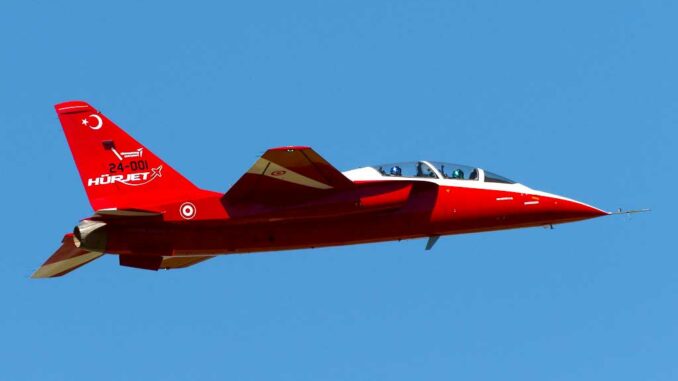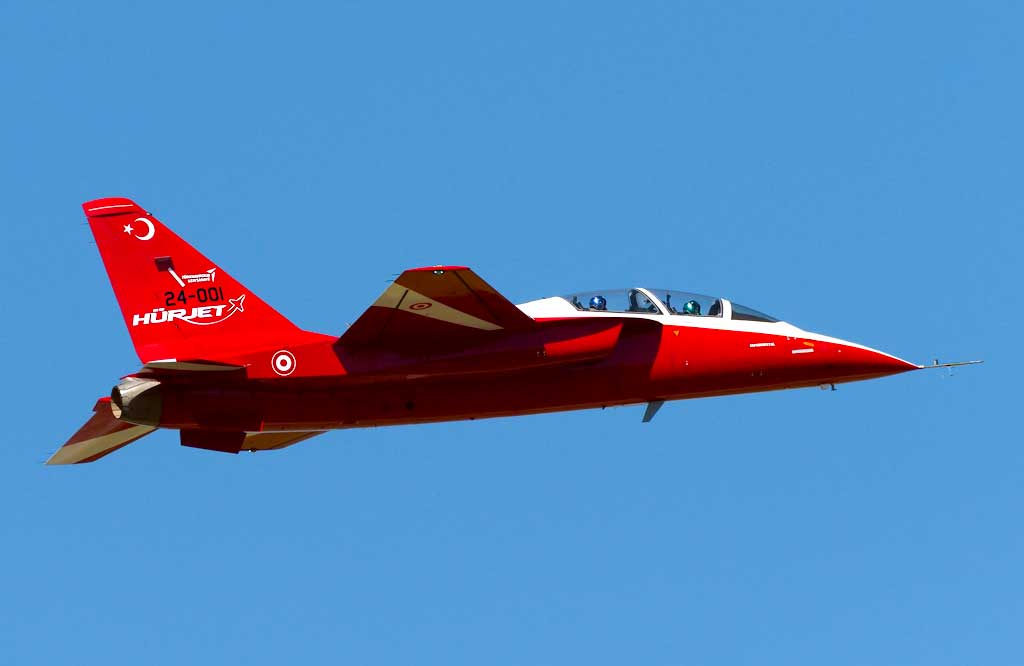
Spain has signed an agreement with TAI and Airbus for 30 Hürjet supersonic training aircraft. Deliveries are scheduled to begin in 2028, strengthening industrial cooperation.
Turkish Aerospace Industries (TAI) has entered into a strategic partnership with Airbus to export up to 30 Hürjet supersonic training aircraft to Spain. Signed at the International Defense Industry Fair (IDEF) 2025 in Istanbul, this agreement marks a key step towards the integration of the Hürjet into European air forces. The contract, expected by the end of 2025, provides for deliveries starting in 2028, with possible local production in Spain. Designed to replace the T-38M and NF-5A/B, the Hürjet combines advanced training and light combat capabilities. With more than 210 test flights and a speed exceeding Mach 1, it has demonstrated its technological maturity. This partnership strengthens Turkey‘s position as a major player in the defense aviation industry in Europe.
Background and significance of the agreement with Spain
On July 24, 2025, Turkish Aerospace Industries (TAI) and Airbus signed a strategic agreement at the International Defense Industry Fair (IDEF) in Istanbul to export up to 30 Hürjet aircraft to Spain. This agreement, formalized after a memorandum of understanding signed in May 2025 with the Spanish Ministry of Defense, marks a significant step forward for Turkey in the military aviation sector. The Hürjet, a supersonic training and light combat aircraft, is intended to replace the Spanish Air Force’s aging fleet of Northrop F-5M aircraft, used to train pilots for the Eurofighter Typhoon and EF-18M Hornet. The agreement provides for possible local production in Spain, involving Spanish companies under the coordination of Airbus, thereby strengthening industrial ties between the two countries.
This agreement comes at a time when Spain is seeking to modernize its air training capabilities. With 19 F-5Ms acquired in the 1960s, the current fleet is obsolete and unable to meet the requirements of modern combat aircraft. The Hürjet, with its advanced avionics and ability to reach Mach 1.4, offers a suitable solution. According to available data, the final contract is expected to be signed by the end of 2025, with deliveries scheduled to begin in 2028. This cooperation illustrates a shared desire to strengthen bilateral relations in the field of air defense, while positioning Turkey as a competitive player in the European market.
Technical characteristics of the Hürjet
The Hürjet is a single-engine, two-seat supersonic trainer aircraft designed by TAI to meet the training needs of modern fighter pilots and for light combat missions. Launched in July 2017, it is intended to replace the T-38M and NF-5A/B aircraft of the Turkish Air Force. Its maiden flight took place on April 25, 2023, and has since completed more than 210 test flights, accumulating approximately 120 flight hours. These tests include supersonic speed flights (up to Mach 0.9 at 9,144 meters altitude), high-angle maneuvers, and weapons testing.
The Hürjet incorporates advanced technologies, including a human-machine interface (HMI) optimized to reduce transition time to fifth-generation aircraft such as the F-35 or the future Turkish KAAN. It is equipped with a General Electric F404-GE-102 engine, which will be partially assembled, inspected, and maintained in Turkey by Turkish Engine Industries (TEI). With a maximum speed of 1.4 Mach and an operating altitude of up to 13,716 meters, the Hürjet offers performance comparable to competitors such as the Boeing T-7A Red Hawk and the Leonardo M-346. Its operating cost, estimated at around one-third that of an F-16, makes it an economical option for air forces.

Impact on the Turkish aviation industry
This agreement marks a decisive step for the Turkish aviation industry, which is seeking to establish itself as a major player on the international stage. Turkey, through TAI, has invested heavily in the development of indigenous technologies to reduce its dependence on foreign platforms. The Hürjet, designed entirely by Turkish engineers, embodies this ambition. With more than 15,200 employees in 2023, including 6,000 engineers, TAI has significant industrial capacity, occupying 5 million square meters in Kahramankazan, near Ankara.
The export of 30 Hürjets to Spain represents the first confirmed European order for this aircraft, reinforcing Turkey’s credibility in the production of military aircraft. According to Mehmet Demiroğlu, CEO of TAI, this agreement illustrates the technological maturity of Turkish industry. In addition, the collaboration with Airbus, a European leader employing 14,000 people in Spain, allows Turkey to integrate into European production chains. This could pave the way for other contracts with NATO countries, particularly in North Africa and Latin America, where Spain has cultural and institutional influence.
Implications for bilateral cooperation between Turkey and Spain
The agreement between TAI, Airbus, and the Spanish Ministry of Defense goes beyond a simple commercial transaction. It is part of an industrial cooperation strategy aimed at strengthening ties between Turkey and Spain, both members of NATO. Local production in Spain, involving companies such as Airtificial for the manufacture of flight control components, guarantees the active participation of Spanish industry. This meets the requirements of the Spanish Ministry, which insists on the integration of local content to support the country’s industrial sovereignty.
This partnership could also have significant economic benefits. In Spain, the aerospace industry is a key sector, with Airbus as the main employer. The production of Hürjet could create additional jobs and stimulate innovation in areas such as integrated training systems. For Turkey, this agreement strengthens its position as a supplier of competitive defense systems, reducing its dependence on US or European imports. However, challenges remain, including the need to bring the Hürjet into line with strict NATO standards for communication, identification, and logistics.
Outlook for the global training aircraft market
The global market for advanced training aircraft is growing rapidly, estimated at around $5.2 billion in 2025, according to industry analysis. Demand is driven by the need to replace aging fleets, such as the T-38 Talon and F-5, and to prepare pilots for fifth-generation aircraft. The Hürjet is positioning itself as a serious competitor to platforms such as the Boeing T-7A, the KAI T-50 and the Leonardo M-346, thanks to its low operating costs and supersonic performance.
The agreement with Spain could serve as a catalyst for further exports. TAI is already targeting markets in North Africa, such as Egypt, where it assembled 46 F-16s in the 1990s, and in Southeast Asia, where countries such as Indonesia are showing interest. Certification to NATO standards and collaboration with Airbus reinforce the Hürjet‘s credibility in these markets. In the long term, this agreement could also pave the way for joint projects, such as the development of a naval version of the Hürjet for the Turkish aircraft carrier TCG Anadolu.
Challenges and limitations to anticipate
Despite its potential, exporting the Hürjet to Spain presents challenges. Customization to meet the specific needs of the Spanish Air Force, such as the integration of systems compatible with the Eurofighter Typhoon, will require complex technical adjustments. In addition, local production in Spain could increase costs, estimated at around €20 million per unit, according to comparisons with similar aircraft. Coordination between TAI and Airbus will also be necessary to avoid delays in the delivery schedule, set for 2028.
Another challenge lies in international competition. Aircraft such as the T-7A Red Hawk, supported by Boeing, or the M-346, already well established in Europe, could limit the expansion of the Hürjet. Finally, geopolitical tensions, such as disputes between Turkey and some NATO members over issues such as the purchase of Russian S-400 systems, could complicate future collaborations.
War Wings Daily is an independant magazine.